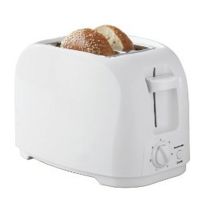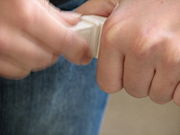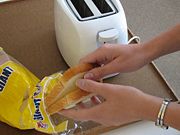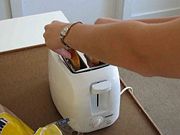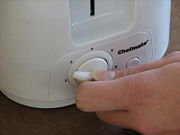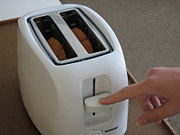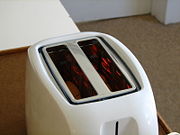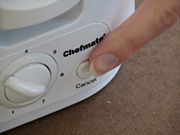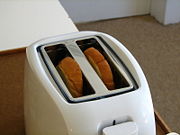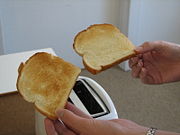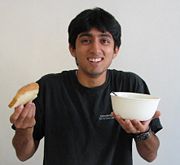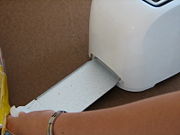|
m |
| (33 intermediate revisions not shown.) |
| Line 1: |
Line 1: |
| - | [[Image:Twotoasters.jpg|right]] | + | [[Image:toaster.jpg|right|200px]] |
| | | | |
| - | = Executive Summary = | + | = Product Use = |
| | | | |
| - | = Product =
| + | Here is a series of photographs depicting a typical customer's interaction with a toaster: |
| | | | |
| - | Our product to dissect and analyze was a toaster. For this part of the project, we purchased a $9.99 Chefmate toaster to dissect. We also purchased a $29.99 Hamilton Beach toaster that we hope to compare with our first toaster at a later date.
| + | {| border="0" style="background:transparent;" |
| | + | |- |
| | + | | |
| | + | [[Image:Toaster_step1.JPG|192px x 155px|thumb|left|Step 1: Plug in Toaster]] |
| | + | || |
| | + | [[Image:Toaster_step2.JPG|192px x 170px|thumb|left|Step 2: Get some type of bread]] |
| | + | || |
| | + | [[Image:Toaster_step3.JPG|192px x 155px|thumb|left|Step 3: Place bread in Toaster slots]] |
| | + | || |
| | + | [[Image:Toaster_step4.JPG|192px x 155px|thumb|left|Step 4: Set desired toasting amount]] |
| | + | |} |
| | | | |
| - | == Stakeholders ==
| + | <br /> |
| | | | |
| - | There are at least four major stakeholders in the production and distribution of a toaster:
| + | {| border="0" style="background:transparent;" |
| - | * Customer
| + | |
| - | * Company
| + | |
| - | * Distributors
| + | |
| - | * Engineers
| + | |
| - | | + | |
| - | The customer is interested in a product that works. [[usability study]]
| + | |
| - | | + | |
| - | The company needs are mostly limited to marketing and finance. They main interest and need is to make a profit. This requires finding customers, low manufacturing costs, and low material costs. This requires the company to decipher customer needs and apply them to their product. It also requires the company to work with the engineers and suppliers to ensure a low-cost product that can easily be sold to stores, or distributers, and thus bought by customers.
| + | |
| - | | + | |
| - | The distributors have similar needs to the company, they are looking to make a profit. Thus their need is to purchase products from various companies that fulfill needs of their customers. So they depend on the company to have come up with the lowest cost product possible.
| + | |
| - | | + | |
| - | The engineers are critical stakeholders, since every other stakeholder's needs has to be met by the engineer's design. The engineers needs are to decrease the amount and cost of material used in the toaster design. It is also the engineers job to design the product using cost and time efficient methods of manufacturing and assembly. Another need of the engineer is to balance cost and design of the product with the environmental impacts caused by the products production/use.
| + | |
| - | | + | |
| - | == Function ==
| + | |
| - | | + | |
| - | = Assembly =
| + | |
| - | | + | |
| - | {| class="wikitable" border="1" | + | |
| - | |-
| + | |
| - | ! Part Number !! Name !! Qty. !! Weight !! Function !! Material !! Maunfacturing Process !! Image !!
| + | |
| - | |-
| + | |
| - | | + | |
| - | | style="text-align: center;" | 001
| + | |
| - | | Plastic Casing
| + | |
| - | | style="text-align: center;" | 1
| + | |
| - | | style="text-align: center;" | 224g
| + | |
| - | | Seperates the internal heating mechanisms from the user.
| + | |
| - | | Polypropylene (PP)
| + | |
| - | | Injection Molded
| + | |
| - | | [[Image:toaster-001.jpg|100px]]
| + | |
| - | |-
| + | |
| - | | style="text-align: center;" | 002
| + | |
| - | | Crumb Tray
| + | |
| - | | style="text-align: center;" | 1
| + | |
| - | | style="text-align: center;" | 36g
| + | |
| - | | Collects bread crumbs.
| + | |
| - | | Aluminum
| + | |
| - | | Stamp
| + | |
| - | | [[Image:toaster-002.jpg|100px]]
| + | |
| - | |-
| + | |
| - | | style="text-align: center;" | 003
| + | |
| - | | Crumb Tray Handle
| + | |
| - | | style="text-align: center;" | 1
| + | |
| - | | style="text-align: center;" | 10 g
| + | |
| - | | Handle to pull out crumb tray.
| + | |
| - | | Plastic
| + | |
| - | | Injection Molded
| + | |
| - | | [[Image:toaster-003.jpg|100px]]
| + | |
| - | |-
| + | |
| - | | style="text-align: center;" | 004
| + | |
| - | | Toaster Loader Top
| + | |
| - | | style="text-align: center;" | 1
| + | |
| - | | style="text-align: center;" | 62g
| + | |
| - | | Bread is loaded through slots.
| + | |
| - | | Stainless Steel
| + | |
| - | | Stamping, Deep Drawing
| + | |
| - | | [[Image:toaster-004.jpg|100px]]
| + | |
| - | |-
| + | |
| - | | style="text-align: center;" | 005
| + | |
| - | | Toaster Base
| + | |
| - | | style="text-align: center;" | 1
| + | |
| - | | style="text-align: center;" | 108g
| + | |
| - | | Base of toaster.
| + | |
| - | | Polypropylene (PP)
| + | |
| - | | Injection Molding
| + | |
| - | | [[Image:toaster-005.jpg|100px]]
| + | |
| - | |-
| + | |
| - | | style="text-align: center;" | 006
| + | |
| - | | Regulator Knob
| + | |
| - | | style="text-align: center;" | 1
| + | |
| - | | style="text-align: center;" | 2g
| + | |
| - | | Adjusts Toast time.
| + | |
| - | | Polypropylene (PP)
| + | |
| - | | Injection Molding
| + | |
| - | | [[Image:toaster-006.jpg|100px]]
| + | |
| - | |-
| + | |
| - | | style="text-align: center;" | 007
| + | |
| - | | Press handle
| + | |
| - | | style="text-align: center;" | 1
| + | |
| - | | style="text-align: center;" | 8g
| + | |
| - | | Easy surface to press, to lower bread into toaster.
| + | |
| - | | Polypropylene (PP)
| + | |
| - | | Injection Molded
| + | |
| - | | [[Image:toaster-007.jpg|100px]]
| + | |
| - | |-
| + | |
| - | | style="text-align: center;" | 008
| + | |
| - | | Cancel button
| + | |
| - | | style="text-align: center;" | 1
| + | |
| - | | style="text-align: center;" | 2g
| + | |
| - | | Cancels toast process
| + | |
| - | | Polypropylene (PP)
| + | |
| - | | Injection Molded
| + | |
| - | | [[Image:toaster-008.jpg|100px]]
| + | |
| - | |-
| + | |
| - | | style="text-align: center;" | 009
| + | |
| - | | Power Cord
| + | |
| - | | style="text-align: center;" | 1
| + | |
| - | | style="text-align: center;" | 12g
| + | |
| - | | Used to power toaster
| + | |
| - | | Rubber and Copper
| + | |
| - | | Extrusion
| + | |
| - | | [[Image:toaster-009.jpg|100px]]
| + | |
| - | |-
| + | |
| - | | style="text-align: center;" | 010
| + | |
| - | | Ejection Assembly: Shaft
| + | |
| - | | style="text-align: center;" | 1
| + | |
| - | | style="text-align: center;" | 12g
| + | |
| - | | Guide rail for ejection assembly
| + | |
| - | | Steel
| + | |
| - | | Extrusion
| + | |
| - | | [[Image:toaster-010.jpg|100px]]
| + | |
| - | |-
| + | |
| - | | style="text-align: center;" | 011
| + | |
| - | | Handle and Locking Part 1
| + | |
| - | | style="text-align: center;" | 1
| + | |
| - | | style="text-align: center;" | 18g
| + | |
| - | | Assists in triggering toasting.
| + | |
| - | | Steel
| + | |
| - | | Stamped and Bent
| + | |
| - | | [[Image:toaster-011.jpg|100px]]
| + | |
| - | |-
| + | |
| - | | style="text-align: center;" | 012
| + | |
| - | | Handle and Locking Part 2
| + | |
| - | | style="text-align: center;" | 6
| + | |
| - | | style="text-align: center;" | 20g
| + | |
| - | | Assists in triggering toasting.
| + | |
| - | | Aluminum
| + | |
| - | | Stamped
| + | |
| - | | [[Image:toaster-012.jpg|100px]]
| + | |
| - | |-
| + | |
| - | | style="text-align: center;" | 013
| + | |
| - | | Toast Shelf
| + | |
| - | | style="text-align: center;" | 2
| + | |
| - | | style="text-align: center;" | 10g
| + | |
| - | | Holds toast in place
| + | |
| - | | Aluminum
| + | |
| - | | Bent
| + | |
| - | | [[Image:toaster-013.jpg|100px]]
| + | |
| - | |-
| + | |
| - | | style="text-align: center;" | 014
| + | |
| - | | Mystery Spring
| + | |
| - | | style="text-align: center;" | 1
| + | |
| - | | style="text-align: center;" | 1g
| + | |
| - | | Used as a spacer, preventing ejection assembly from moving beyond a certain distance.
| + | |
| - | | Steel
| + | |
| - | | Extrusion
| + | |
| - | | [[Image:toaster-014.jpg|100px]]
| + | |
| - | |-
| + | |
| - | | style="text-align: center;" | 015
| + | |
| - | | Restoring Spring
| + | |
| - | | style="text-align: center;" | 1
| + | |
| - | | style="text-align: center;" | 4g
| + | |
| - | | Restoring Spring
| + | |
| - | | Steel
| + | |
| - | | Extrusion
| + | |
| - | | [[Image:toaster-015.jpg|100px]]
| + | |
| - | |-
| + | |
| - | | style="text-align: center;" | 016
| + | |
| - | | Magnetic Lock Piece
| + | |
| - | | style="text-align: center;" | 1
| + | |
| - | | style="text-align: center;" | 8g
| + | |
| - | | Attracts to magnet to lock the toasting shelf.
| + | |
| - | | Steel
| + | |
| - | | Stamped and Bent
| + | |
| - | | [[Image:toaster-016.jpg|100px]]
| + | |
| - | |-
| + | |
| - | | style="text-align: center;" | 017
| + | |
| - | | Insulating caps for locking mechanism.
| + | |
| - | | style="text-align: center;" | 2
| + | |
| - | | style="text-align: center;" | 2g
| + | |
| - | | N/A
| + | |
| - | | ABS
| + | |
| - | | Injection Molding
| + | |
| - | | [[Image:toaster-017.jpg|100px]]
| + | |
| - | |-
| + | |
| - | | style="text-align: center;" | 018
| + | |
| - | | Shaft Spacer
| + | |
| - | | style="text-align: center;" | 1
| + | |
| - | | style="text-align: center;" | 2g
| + | |
| - | | Spacer
| + | |
| - | | ABS
| + | |
| - | | Extrusion
| + | |
| - | | [[Image:toaster-018.jpg|100px]]
| + | |
| - | |-
| + | |
| - | | style="text-align: center;" | 019
| + | |
| - | | Trigger Switch
| + | |
| - | | style="text-align: center;" | 1
| + | |
| - | | style="text-align: center;" | 2
| + | |
| - | | Triggers switch that activates the heating coils.
| + | |
| - | | ABS
| + | |
| - | | Injection Molding
| + | |
| - | | [[Image:toaster-019.jpg|100px]]
| + | |
| - | |-
| + | |
| - | | style="text-align: center;" | 020
| + | |
| - | | Circuit Board
| + | |
| - | | style="text-align: center;" | 1
| + | |
| - | | style="text-align: center;" | 12g
| + | |
| - | | Controls heating mechanism and switch release.
| + | |
| - | | Silicon and Electrical Components
| + | |
| - | | N/A
| + | |
| - | | [[Image:toaster-020.jpg|100px]]
| + | |
| - | |-
| + | |
| - | | style="text-align: center;" | 021
| + | |
| - | | Electromagnet, Switch Release, Circuit Board #2
| + | |
| - | | style="text-align: center;" | 1
| + | |
| - | | style="text-align: center;" | 46g
| + | |
| - | | Electromagnet releases shelf, releasing the switch. Also powers the heating elements.
| + | |
| - | | Silicon and Electrical components
| + | |
| - | | N/A
| + | |
| - | | [[Image:toaster-021.jpg|100px]]
| + | |
| - | |-
| + | |
| - | | style="text-align: center;" | 022
| + | |
| - | | Heating Coil
| + | |
| - | | style="text-align: center;" | 3
| + | |
| - | | style="text-align: center;" | 1g
| + | |
| - | | Heats up when current passes through it.
| + | |
| - | | Tungsten?
| + | |
| - | | ?
| + | |
| - | | [[Image:toaster-022.jpg|100px]]
| + | |
| - | |-
| + | |
| - | | style="text-align: center;" | 023
| + | |
| - | | Mica Insulating Sheet
| + | |
| - | | style="text-align: center;" | 3
| + | |
| - | | style="text-align: center;" | 14g
| + | |
| - | | Insulating sheet, also carries the heating coil.
| + | |
| - | | Mica
| + | |
| - | | Pressed and chemically treated
| + | |
| - | | [[Image:toaster-023.jpg|100px]]
| + | |
| - | |-
| + | |
| - | | style="text-align: center;" | 024
| + | |
| - | | Mica Aligning Strips
| + | |
| - | | style="text-align: center;" | 6
| + | |
| - | | style="text-align: center;" | 1g
| + | |
| - | | Used to keep heating coils in place.
| + | |
| - | | Mica
| + | |
| - | | Pressed and chemically treated
| + | |
| - | | [[Image:toaster-024.jpg|100px]]
| + | |
| - | |-
| + | |
| - | | style="text-align: center;" | 025
| + | |
| - | | Circut Board Insulator
| + | |
| - | | style="text-align: center;" | 1
| + | |
| - | | style="text-align: center;" | 1g
| + | |
| - | | Prevents the two circuit boards from shorting.
| + | |
| - | | Mica
| + | |
| - | | Pressed and chemically treated
| + | |
| - | | [[Image:toaster-025.jpg|100px]]
| + | |
| - | |-
| + | |
| - | | style="text-align: center;" | 026
| + | |
| - | | Heater leads
| + | |
| - | | style="text-align: center;" | 3
| + | |
| - | | style="text-align: center;" | 2g
| + | |
| - | | Used to carry current to heater coils
| + | |
| - | | ?
| + | |
| - | | Extruded and Bent
| + | |
| - | | [[Image:toaster-026.jpg|100px]]
| + | |
| - | |-
| + | |
| - | | style="text-align: center;" | 027
| + | |
| - | | Smaller Mica Insulator
| + | |
| - | | style="text-align: center;" | 2
| + | |
| - | | style="text-align: center;" | 1g
| + | |
| - | | Insulating purposes
| + | |
| - | | Mica
| + | |
| - | | Pressed chemically treated
| + | |
| - | | [[Image:toaster-027.jpg|100px]]
| + | |
| - | |-
| + | |
| - | | style="text-align: center;" | 028
| + | |
| - | | Toaster wall #1
| + | |
| - | | style="text-align: center;" | 1
| + | |
| - | | style="text-align: center;" | 32g
| + | |
| - | | Structural support, guides toast shelf
| + | |
| - | | Steel
| + | |
| - | | Stamped and Bent
| + | |
| - | | [[Image:toaster-028.jpg|100px]]
| + | |
| - | |-
| + | |
| - | | style="text-align: center;" | 029
| + | |
| - | | Base Plate
| + | |
| - | | style="text-align: center;" | 1
| + | |
| - | | style="text-align: center;" | 60g
| + | |
| - | | Holds everything in place, structural support
| + | |
| - | | Steel
| + | |
| - | | Stamped and Bent
| + | |
| - | | [[Image:toaster-028.jpg|100px]]
| + | |
| - | |-
| + | |
| - | | style="text-align: center;" | 030
| + | |
| - | | Toaster wall #2
| + | |
| - | | style="text-align: center;" | 1
| + | |
| - | | style="text-align: center;" | 24g
| + | |
| - | | Guides far end of toast shelf
| + | |
| - | | Steel
| + | |
| - | | Stamped and Bent
| + | |
| - | | [[Image:toaster-029.jpg|100px]]
| + | |
| - | |-
| + | |
| - | | style="text-align: center;" | 031
| + | |
| - | | Radiation Shield
| + | |
| - | | style="text-align: center;" | 2
| + | |
| - | | style="text-align: center;" | 32g
| + | |
| - | | Prevents heat from radiating to the walls of the toaster.
| + | |
| - | | Steel
| + | |
| - | | Stamped and Bent
| + | |
| - | | [[Image:toaster-030.jpg|100px]]
| + | |
| - | |-
| + | |
| - | | style="text-align: center;" | 032
| + | |
| - | | Small mica tabs
| + | |
| - | | style="text-align: center;" | 7
| + | |
| - | | style="text-align: center;" | 1g
| + | |
| - | | Holds various wires in place
| + | |
| - | | Mica
| + | |
| - | | Pressed and chemically treated
| + | |
| - | | [[Image:toaster-031.jpg|100px]]
| + | |
| - | |-
| + | |
| - | | style="text-align: center;" | 033
| + | |
| - | | Bread Holder support wires
| + | |
| - | | style="text-align: center;" | 8
| + | |
| - | | style="text-align: center;" | 2g
| + | |
| - | | Supports the toastee to be upright.
| + | |
| - | | Aluminum
| + | |
| - | | Extrusion and Bent
| + | |
| - | | [[Image:toaster-032.jpg|100px]]
| + | |
| - | |-
| + | |
| - | | style="text-align: center;" | 034
| + | |
| - | | Mica sheet support beams
| + | |
| - | | style="text-align: center;" | 3
| + | |
| - | | style="text-align: center;" | 4g
| + | |
| - | | Helps keep mica sheets in place.
| + | |
| - | | Steel
| + | |
| - | | Stamped and Bent
| + | |
| - | | [[Image:toaster-033.jpg|100px]]
| + | |
| - | |-
| + | |
| - | | style="text-align: center;" | 035
| + | |
| - | | Rubberized No slip pads
| + | |
| - | | style="text-align: center;" | 2
| + | |
| - | | style="text-align: center;" | 0.5g
| + | |
| - | | Helps keep toaster from sliding
| + | |
| - | | Urethane
| + | |
| - | | Extruded, Cut
| + | |
| - | | [[Image:toaster-034.jpg|100px]]
| + | |
| - | |-
| + | |
| - | | style="text-align: center;" | 036
| + | |
| - | | Control knob ring
| + | |
| - | | style="text-align: center;" | 1
| + | |
| - | | style="text-align: center;" | 6g
| + | |
| - | | Support for knob
| + | |
| - | | Polypropylene (PP)
| + | |
| - | | injection Molded
| + | |
| - | | [[Image:toaster-035.jpg|100px]]
| + | |
| | |- | | |- |
| | + | | |
| | + | [[Image:Toaster_step5.JPG|192px x 155px|thumb|left|Step 5: Pull down handle to start toasting]] |
| | + | || |
| | + | [[Image:Toaster_step6.JPG|192px x 170px|thumb|left|Step 6: Wait while bread is toasting to desired level]] |
| | + | || |
| | + | [[Image:Toaster_step7.JPG|192px x 155px|thumb|left|Step 7: If you want to stop it early, press cancel]] |
| | + | || |
| | + | [[Image:Toaster_step8.JPG|192px x 155px|thumb|left|Step 8: Bread pops up when done or cancel button is pressed]] |
| | |} | | |} |
| | | | |
| - | =Product Analysis=
| |
| | | | |
| - | For our product evaluation, we looked at four different types of analysis. Design for Manufacture and Assembly (DFMA), Failure Mode Evaluation and Analysis (FMEA), Design for Environment (DFE), and a quantitative mechanical analysis.
| + | <br /> |
| | | | |
| - | ==DFMA Analysis== | + | {| border="0" style="background:transparent;" |
| - | | + | |
| - | ==FMEA Analysis==
| + | |
| - | | + | |
| - | ==DFE Analysis==
| + | |
| - | | + | |
| - | Putting a slice of bread in the toaster, one does not often think about the environmental implications this act may have: “What steps were taken to enable this toaster to arrive on my countertop, how much power is it using while toasting, and what will happen to it after it I throw it away?” Delving into the life cycle of a toaster, we see that there is much room for improvement.
| + | |
| - |
| + | |
| - | The key element in the life cycle of this appliance is energy. Being made of nearly completely recyclable materials, we are not focusing on the post-use phase. In both the production and use phases of a toaster, power generation and supply is the overwhelming contributor of greenhouse gas emissions. This seems fairly straightforward for the use end – in use, toasters produce little more than heat, from electrical power, and (hopefully) golden brown toast – but this may come as a surprise for the manufacturing end. Indeed, power generation and supply produces nearly four times as much CO2-equivalent than the nearest sectors, truck transportation and steel mills, during the manufacturing of such appliances.
| + | |
| - | | + | |
| - | Using the EIO-LCA software from Carnegie Mellon University’s Green Design Institute, we see that every $1,000,000 of production in the ‘Electric housewares and household fans’ sector produces 693 MTCO2E. Given our $10 toaster, this shows us that approximately 0.007 MTCO2E caused by the manufacturing of one toaster. To compare that to the use end, a simple calculation is done:
| + | |
| - | | + | |
| - | From the EIO-LCA, we see that for every $1,000,000 of production in the ‘Power generation and supply’ sector, 9910 MTCO2E are emitted.
| + | |
| - | | + | |
| - | Assuming: $0.10/kWh electricity cost, power consumption is 800W, usage is 6 min (0.1hr) per day, used 300 days out of the year, over the course of a 4 year use-life.
| + | |
| - | We see that it would cost approximately $9.60 to run this toaster over the course of its life. Given this information, it is seen that the use phase of a toaster’s life emits approximately 0.095 MTCO2E. This is an entire order of magnitude higher than the emissions production phase. Clearly, one of our assumptions, above, needs to be modified. The only option which may not impact the functionality and longevity of the toaster is the power consumption.
| + | |
| - |
| + | |
| - | The results for conventional air pollutants, such as SO2, NOx, and CO, show the same result: power generation, both for the creation and use of a toaster, is the largest contributor to harmful emissions.
| + | |
| - | | + | |
| - | Furthermore, looking at other toasters, we see that this 800W usage is on the low end of the spectrum. All residential toasters use the same heating method – running current through a filament, which generates heat. Perhaps a thorough rethinking of the method used to toast the bread is necessary.
| + | |
| - | | + | |
| - | The numerical results of GHG emissions, above, come with a good level of confidence. Though there are many sub-sectors of the ‘Electric housewares and household fans’ segment, the ‘Small electric household cooking appliances’ sub-sector represents nearly 1/3 of the overall sector.
| + | |
| - | | + | |
| - | {|-
| + | |
| - | | '''EIO-LCA GHG Results for Electric Housewares and Household Fans'''
| + | |
| - | |-
| + | |
| - | | [[Image:ToasterghgTable.jpg]]
| + | |
| - | |-
| + | |
| - | | [[Image:ToasterghgChart.jpg]]
| + | |
| - | |-
| + | |
| - | | '''EIO-LCA GHG Results for Power Generation and Supply'''
| + | |
| - | |-
| + | |
| - | | [[Image:ToasterghgPowertable.jpg]]
| + | |
| - | |-
| + | |
| - | | [[Image:ToasterghgPowerchart.jpg]]
| + | |
| | |- | | |- |
| | + | | |
| | + | [[Image:Toaster_step9.JPG|192px x 155px|thumb|left|Step 9: a beautiful golden brown ]] |
| | + | || |
| | + | [[Image:Toaster_step10.JPG|192px x 170px|thumb|left|Step 10: Enjoy]] |
| | + | || |
| | + | [[Image:Toaster_step11.JPG|192px x 155px|thumb|left|Cleaning: remove crumb tray to throw away crumbs fallen in toaster]] |
| | |} | | |} |
| | | | |
| - | ==Mechanical Analysis== | + | = User = |
| | + | For a toaster, users fall into a wide range of people. This includes all ages and economic status, but tend to be limited to people who own or have access to a kitchen. The only major restriction is that toasters requires a user to have a supply of electricity in their household. |
| | | | |
| - | =References=
| + | For this usability study, we sent around a survey and interviewed several people who have interacted with a toaster on a regular basis. The results of this study is shown below. |
| | | | |
| - | Degentesh, Drew. "Metal Processing." 24-443: Design for Manufacture. Carnegie Mellon University. 11 Sept. 2008.
| + | == Needs == |
| | | | |
| - | Degentesh, Drew. "Injection Molding." 24-443: Design for Manufacture. Carnegie Mellon University. 4 Sept. 2008.
| + | * to toast bread |
| | + | * low cost |
| | + | * easy usability |
| | + | * ability to use a wide variety of bread |
| | | | |
| - | Degentesh, Drew. "Plastics Processing." 24-443: Design for Manufacture. Carnegie Mellon University. 2 Sept. 2008.
| + | == Likes == |
| | | | |
| - | Thompson, Rob. Manufacturing Processes for Design Professionals. London: Thames & Hudson, 2007.
| + | * golden brown toast |
| | + | * cancel button |
| | + | * well-defined settings |
| | + | * [http://www.engadget.com/2008/09/12/scan-toaster-puts-the-power-of-miracle-toast-into-the-hands-of/ custom printed toast] |
| | | | |
| - | [http://ddl.me.cmu.edu/ddwiki/index.php/ED2 Engineering Design II Course]
| + | == Annoyances == |
| | | | |
| - | Carnegie Mellon University Green Design Institute. [http://www.eiolca.net/ (2008) Economic Input-Output Life Cycle Assessment (EIO-LCA) model]
| + | * bread gets stuck inside the toaster |
| | + | * unreliability of toaster settings |
| | + | * hard to clean |
| | + | * burned sides of wider bread |
| | + | * toast doesn't come out of the toaster high enough to grab it. |
| | | | |
| - | =Team Members= | + | = Possible Usability Improvements = |
| | | | |
| - | {|-align="right"
| + | From our usability study data we have come up with several possible usability improvements: |
| - | ! Leigh Fortenberry !! Jon Goettler !! Akshay Jayaram !! Ian Price !!
| + | |
| - | |-
| + | |
| - | |[[Image:Toaster-Leigh.JPG|200px]]
| + | |
| - | |[[Image:Toaster-Jon.JPG|200px]]
| + | |
| - | |[[Image:ToasterAkshay.JPG|200px]]
| + | |
| - | |[[Image:Toaster-Ian.JPG|200px]]
| + | |
| - | |-
| + | |
| | | | |
| - | | style="text-align: center;" | Worked on DFMA, usability study, Stakeholder's needs
| + | * including a cancel button on the toaster to give more user control (already part of our dissected product) |
| - | | style="text-align: center;" | Worked on FMEA, Mechanical Analysis, analysis of timing system
| + | * have toast lifted higher after toasting for easy and pain-free removal |
| - | | style="text-align: center;" | Worked on Component List, Executive Summary, and usability study stunt dummy.
| + | * widening slots after toasting in order to remove wider bread products easily |
| - | | style="text-align: center;" | Worked on DFE, Product and System Function
| + | * allow toaster to fit a wide variety of bread sizes, keeping bread from either not being toasted or being burned on edges. |
| - | |-
| + | |
| - | |}
| + | |
Here is a series of photographs depicting a typical customer's interaction with a toaster:
For a toaster, users fall into a wide range of people. This includes all ages and economic status, but tend to be limited to people who own or have access to a kitchen. The only major restriction is that toasters requires a user to have a supply of electricity in their household.
For this usability study, we sent around a survey and interviewed several people who have interacted with a toaster on a regular basis. The results of this study is shown below.
From our usability study data we have come up with several possible usability improvements:
